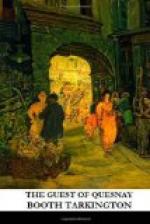About the procession, as it moves interminably along the boulevard, a blue haze of fine dust and burnt gasoline rises into the sunshine like the haze over the passages to an amphitheatre toward which a crowd is trampling; and through this the multitudes seem to go as actors passing to their cues. Your place at one of the little tables upon the sidewalk is that of a wayside spectator: and as the performers go by, in some measure acting or looking their parts already, as if in preparation, you guess the roles they play, and name them comedians, tragedians, buffoons, saints, beauties, sots, knaves, gladiators, acrobats, dancers; for all of these are there, and you distinguish the principles from the unnumbered supernumeraries pressing forward to the entrances. So, if you sit at the little tables often enough—that is, if you become an amateur boulevardier—you begin to recognise the transient stars of the pageant, those to whom the boulevard allows a dubious and fugitive role of celebrity, and whom it greets with a slight flutter: the turning of heads, a murmur of comment, and the incredulous boulevard smile, which seems to say: “You see? Madame and monsieur passing there—evidently they think we still believe in them!”
This flutter heralded and followed the passing of a white touring-car with the procession one afternoon, just before the Grand Prix, though it needed no boulevard celebrity to make the man who lolled in the tonneau conspicuous. Simply for that, notoriety was superfluous; so were the remarkable size and power of his car; so was the elaborate touring-costume of flannels and pongee he wore; so was even the enamelled presence of the dancer who sat beside him. His face would have done it without accessories.




